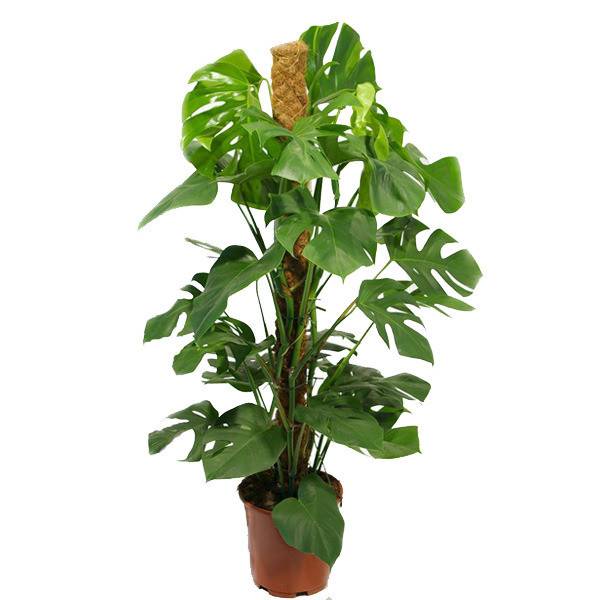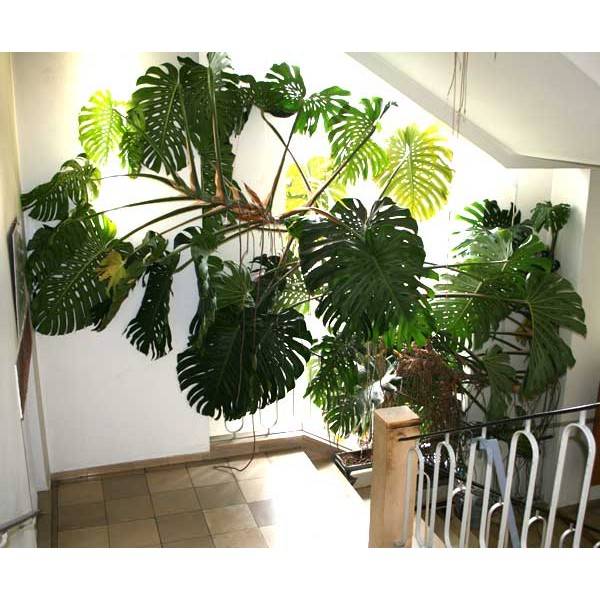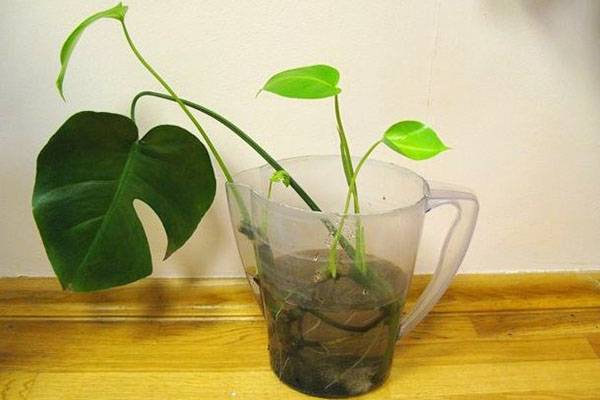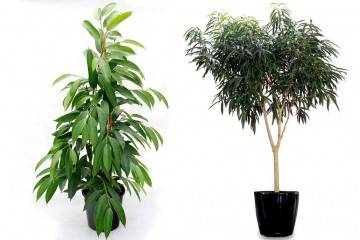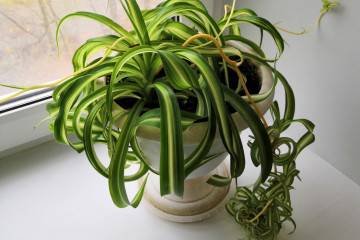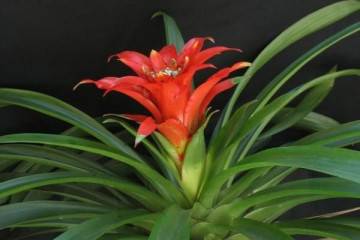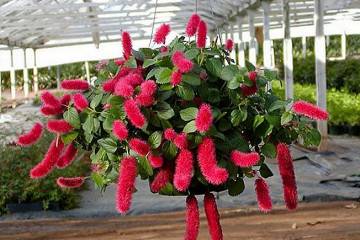Monstera flower - home care
Content:
Monstera is a flower that belongs to unpretentious indoor plants that do not require special care. The tropical vine loves sunlight, a certain level of humidity, blooms with proper supervision and produces exotic fruits that taste like pineapple.
What does it look like and what family it belongs to
Monstera (in Latin "monstera") belongs to the Aroid family. This evergreen plant, framed with aerial roots, has won many hearts of lovers of home flowers. Its foliage is large with natural cuts of various sizes and feathery venation.
Common varieties
The flower has many varieties. Particular attention is paid to individual copies, which are presented:
- Variegated (variegated white monster). Differs in moodiness in content, slow growth. In addition to the openwork frame, there are white patterns on the carved foliage that cover half of them. With age, the monster Alba has more of them. The stem of the plant is also colorful;
- monster attractive, or delicious. In an apartment, this type can grow up to 3 m. Large sheets (up to 1 m long, up to 0.5 m wide) are decorated with figured slots;
- monster karstenianum. Differs in rapid growth, after 4 years it can occupy half of the room. It does not tolerate drafts, since under the influence of cold air the foliage becomes brown, begins to fade and dry.
Healing properties
The monstera plant in Mexico is used as a base for drugs that help fight arthritis and other joint diseases. At home, it helps to cope with the harmful formaldehyde that is released from building materials, constantly absorbing it. The monstera leaf collects dust, ionizes the air and removes excess carbon dioxide from it. At night, the flower actively absorbs oxygen. Due to this feature, it is not recommended to install it in the bedroom.
Briefly about the history of appearance
The rainforests of Central America are the birthplace of the flower. It is common in Mexico, Panama, Costa Rica, and Guatemala. In Australia and Asia, it began to be bred for the sake of edible berries, in moderate climatic conditions - as an ornamental deciduous plant for apartments, winter gardens and greenhouses.
Monstera: home care
How to care for a home monster? The grown plant needs support, otherwise its stem may break. Artificial trunks up to 1 m in height are sold in flower shops.
Temperature
According to the description, the best temperature regime for a flower is the range of 18-22 ° C. In winter, it can drop to 16-18 ° C, sharp fluctuations are contraindicated for it.
Lighting
Home care for a monstera flower does not require a special light regime. The best conditions for growth and development are considered to be the east or west side. In the summer heat, monstera sheets must be protected from the scorching sun rays to avoid serious burns.
Watering
The houseplant loves abundant moisture, but it also tolerates uneven watering well. In the summer months, the care of the variegated monster is carried out more often, in the winter - less often. It is better to observe the golden mean: do not allow the earthen coma to be absolutely dry and do not bring it to waterlogging.
Spraying
The homeland of the flower is the humid tropics, so the plant does not require strict adherence to light and temperature conditions, but prefers periodic irrigation of the foliage. Experienced gardeners recommend dusting it and washing it monthly, regardless of the season.
Humidity
Indoor humidity indicators should be above average, in extreme cases they can be maintained at 60%. The higher the temperature in the room in summer, the more often the flower needs water treatments.
Priming
The plant mix should be loose, nutritious, and good at retaining moisture. It is better to choose soil for a domesticated monster with a neutral indicator. Coconut fiber or perlite is added to special nutritious soil mixtures for decorative leafy varieties.
Top dressing
The flower is fed in March-September with complex mineral fertilizers at least once a month. If it is actively developing, then the amount of feeding recommended in the instructions is reduced by 2 times.
Do not fertilize in winter. You can only add humus to the top layer.
Aerial roots
Aerial roots are formed on the lower part of the stem near the leaves. They are a secondary source of nutrients and water when introduced into the soil. This feature helps the monster to grow and develop faster, and to support young stems.
Winter care
The plant does not have a pronounced dormant period, it does not lose foliage in the fall. When the temperature drops to 20 ° C and the day length decreases, its growth stops. The flower tolerates winter well without feeding and with poor watering. Immediately after changing the temperature regime and under artificial lighting, it wakes up and begins to actively grow.
Plant formation
Form a monster by tying aerial roots to a support. Subsequently, they will grow into it. This helps the plant to strengthen the trunk and not break, improves the appearance. A flower that is too long is cut off from above.
When and how monstera blooms
When conditions are close to natural, monstera is capable of blooming. The first flowering is observed in 2-3 years.
The flowers of the plant are bisexual with a white or pale cream shade.The middle is greenish-yellow. The flowers are shaped like elongated cylinders.
Home monstera blooms with small flowers that are collected in an inflorescence. Its length is from 20 to 25 cm, and in shape it resembles an ear of corn with an additional blanket of white-cream shade.
Under natural conditions, the phenomenon is observed annually. At home, only with proper care and sufficient feeding once every few years.
Pruning
To prevent the flower from growing actively, in early spring, the top with several internodes is cut off from it. The cut site is disinfected with crushed coal. The cut off top can be rooted in water or soil.
Transfer
The transplant is carried out according to the algorithm:
- in the first 2 years - annually;
- at 3-4 years old - 1 time in 2 years;
- after 5 years - every 3-4 years.
To transplant young growth, it is necessary to use neutral or slightly acidic soil with a pH of 5.5 to 6.0. Potting mix includes:
- peat - 1 part;
- turf - 1 part;
- humus - 2 parts;
- sand - 1 part.
When transplanting adult bushes, the pH is increased to 6.5-7. The mixture should consist of humus, turf, sand and leafy earth (the first three components are taken in 1 part, the last - 3 parts). The box is chosen large, its bottom is filled with a good drainage layer.
Is it possible to cut aerial roots
Correct cultivation of monstera does not require their removal. They are carefully bent over and directed into the ground.
Is it possible to cut the aerial roots of a monstera when creating a bush? Most of them are located at the bottom of the stem and are not affected when the apex is removed. Their presence does not spoil the interior, and accidental damage can lead to an insufficient supply of nutrients and water to the main plant.
Reproduction is possible not only by aerial roots. To obtain shoots, it is enough to plant the cut off top in a nutritious soil, separate leaves in a glass of water. You can propagate with aerial roots located along with the shoots: tie moss to them, cover it loosely with polyethylene on top, water it periodically. After obtaining a reliable root system, part of the stem is cut off, the resulting shoot is planted separately.
Can I take it outside
Professionals do not recommend taking the monster out to the loggia or garden. Sudden changes in temperature at night will have a bad effect on the condition of the flower, it can die from hypothermia.
Monstera is one of the most beautiful decorative leafy representatives that are grown at home. It is widely used as an interior decoration, especially in the presence of large and spacious rooms. There should be no problems in planting and leaving, but it is worth remembering that the flower quickly takes up free space.


